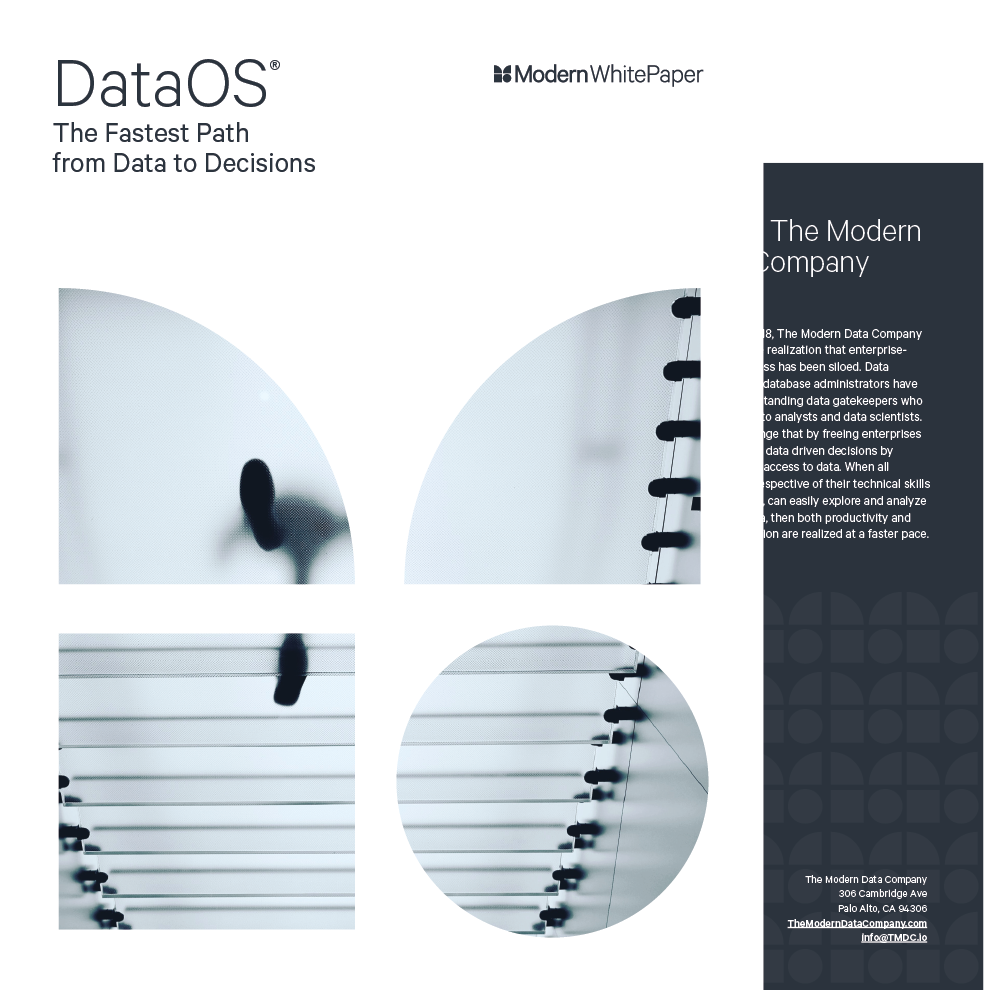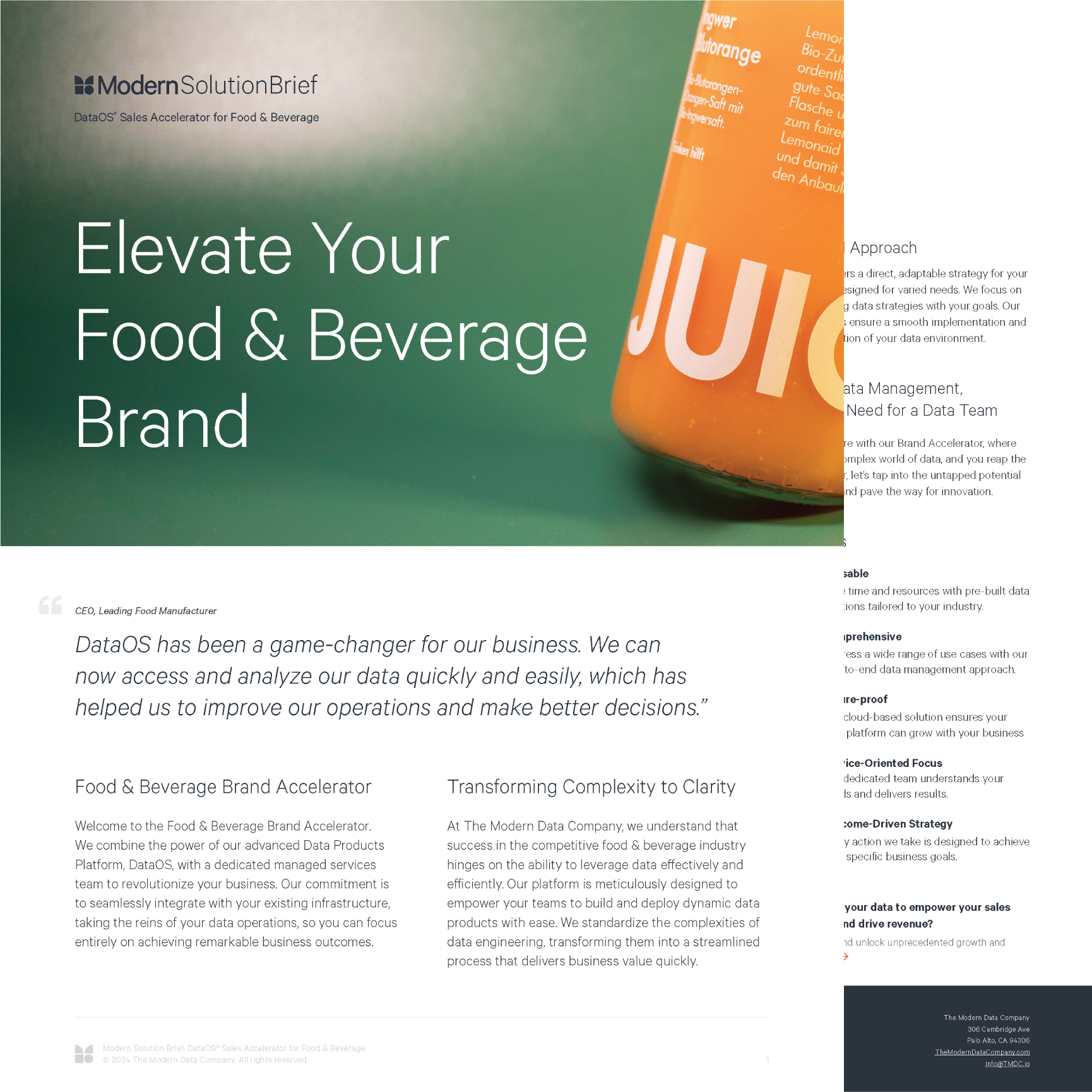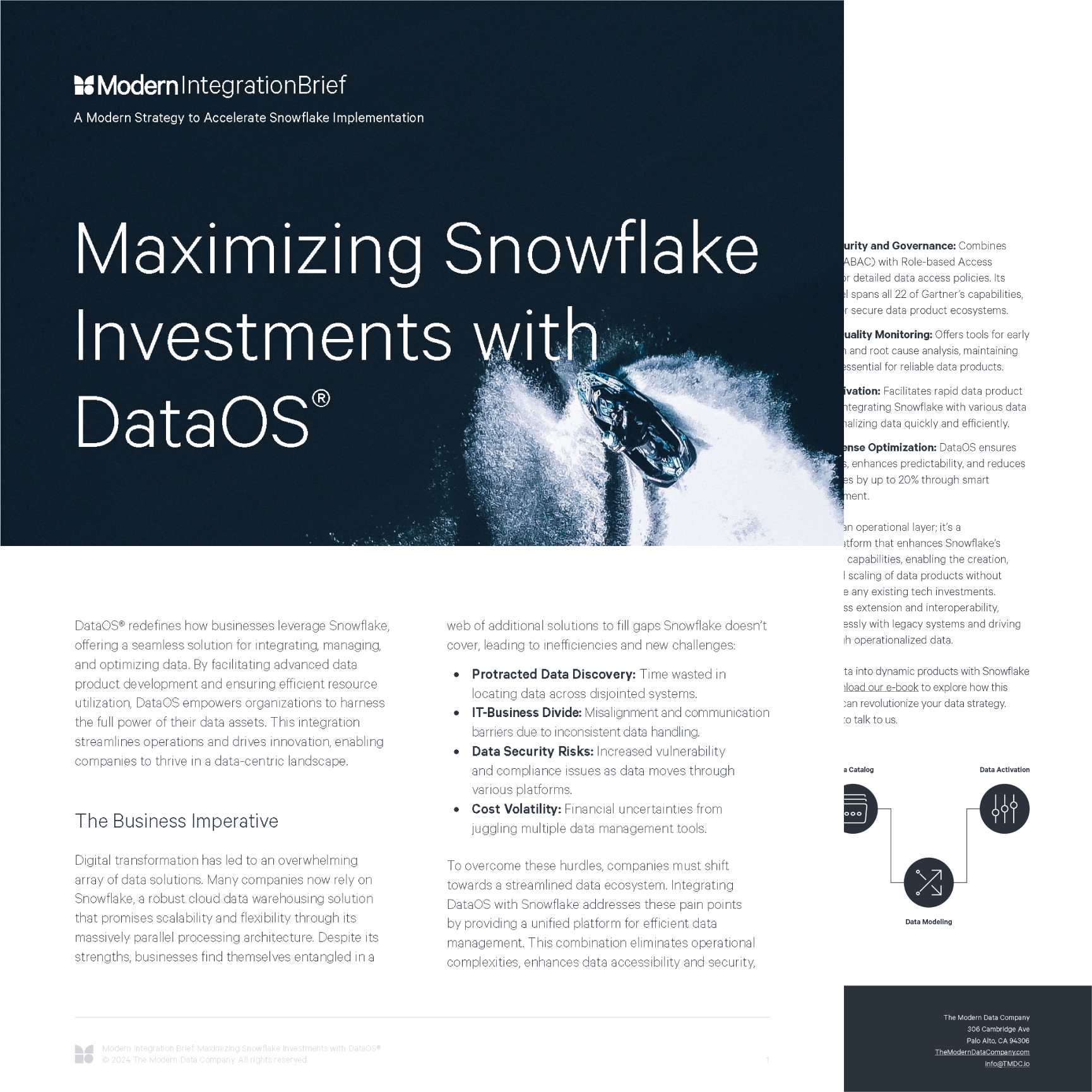
How to drive trusted decisions without changing your current data infrastructure.
Learn more about DataOS® in our white paper.
Enterprises today have lots of data. This includes legacy data, partner data, transactional data, third-party data, and more. Most enterprises purchase many point solutions trying to create a complete and flexible data ecosystem. The problem is that the demands for what data is required and how it should be used keep changing. Companies need a brand new way to think about data management.
It requires constant work in order for businesses to keep up with all of these changes and stay ahead. With each new data source or analytical requirement, companies add yet another tool to the set of previously purchased solutions, introducing even more complexity. This leads to many points of potential failure and risk as well as a large volume of ongoing integration work.
With each new tool, the time and effort required to implement and manage all of these solutions becomes not only overwhelming, but also unsustainable. If a major disruption like the COVID crisis hits, companies are done–what’s in place isn’t adaptable enough or scalable enough to handle the disruption in the timeframe required.
Enterprises need one data platform they can manage internally and that handles all data, at any speed, in a governed and compliant manner. More importantly, this data platform should help accelerate the time to value on all other data investments because they gain one view of all enterprise data.
Companies don’t actually need yet another service to handle their data. They need a one-time upgrade to a comprehensive solution: a data operating system built on top of a data fabric, which represents the next generation of data management technologies. Let’s explore the problem with choosing a service and what comprehensive data management looks like with a modern data fabric architecture.
Organizations can adopt any service they want—Software-as-a-Service, Platform-as-a-Service, DevOps-as-a-Service, Newest-Hype-Cycle-Keyword-as-a-Service. Adopting services may be appropriate in some circumstances, but when it comes to the overall health of data, a service isn’t the right response. This is why.
In a service context, the vendor manages everything. That’s great for putting on an event or planning an all-inclusive vacation but not so great for data management. The more entrenched the service becomes, the more control the organization relinquishes. In addition, there may be little to no knowledge internally related to what the vendor is actually doing on the company’s behalf, which adds immense risk into the mix if for whatever reason the vendor relationship sours.
Companies don’t want to be dependent on vendors for mission critical functionality. True digital transformation requires an enterprise to have data in motion, easily usable for all stakeholders, and —most importantly—being governed by the enterprise itself, not a wide range of third-party service providers. Turning control of enterprise data over to a third-party service, however convenient it may seem, will only add another layer of complexity to the management of that data.
With a robust data operating system, companies retain complete control over their data, how it is governed, and how it is used. They understand the birds-eye view of their data’s landscape, can make immediate decisions for governance and usage, and don’t need to rely on a third party to be able to use data.
Software as a Service (SaaS) models create recurring revenue by charging for usage, so needed changes can come at a steep cost when an enterprise needs to grow or pivot. As a company’s data grows in size and the organization’s use of that data expands, additional charges will add up quickly. Additionally, if the SaaS provider changes its business model, companies might waste resources in negotiations to continue with their current functionality only to eat those costs along with a price increase to maintain their data access.
On top of growing service costs, committing to a service can backfire in mobility. Many SaaS companies cannot survive the cutthroat world of tech; when they go under, it’s on the enterprise to move data to the next service. The entire investment in the previous SaaS platform is lost, and the company must start from scratch by porting everything over to a new vendor. Even aside from the steep costs, downtime alone can be catastrophic.
With a data fabric solution, companies leverage a modular solution that grows and changes with the enterprise’s needs while paying a single fee for access to the solution rather than following a pay-as-you-go model that charges for each action users undertake. Companies can integrate all current solutions and legacy systems knowing that they can alter the environment to handle new requirements and components as circumstances change.
Many SaaS companies offer some governance controls to the partner enterprise, but ultimately, the access the service provides companies to their own data is a potential security vulnerability. Identity and access management must be addressed, security protocols updated regularly, and with a new remote workforce, mobile access must be closely monitored. The more SaaS providers a company works with, the more providers that must be constantly monitored and audited to ensure that their practices are up to date. Plus, storing data in the service provider’s vaults may not satisfy ever-changing regulations.
For some companies, the risk can lead to disaster. Compliance breaches cost companies millions, so trusting a wide spectrum of third-party solution providers for the long haul could be too great a risk at too high a price. A recent study from the Ponemon Institute outlines just how risky third-party access can be if it isn’t managed properly. It found 63% of respondents don’t have visibility into the level of access and permissions in place for internal and external users. More worrisome, the study found that over half of survey respondents experienced security breaches stemming from providing access to third-party services.
A data fabric puts granular governance controls directly in the hands of the company’s decision-makers. This extends to all devices located on the network and keeps data access compliant and secure without tying it up in silos. Having this control within the company’s walls provides the highest level of transparency while simultaneously increasing security levels.
Services often have higher latency than an on-premise solution and require continual connectivity. So what happens when the SaaS server goes down? The company loses access to its data and insights until the connection is operational again. Rather than having control of its own resources to resolve the issues, the company is fully dependent on the service provider and the skill and resources that the provider is able to deploy to resolve the issue. In some cases, performance-related issues could spur the company to invest in faster internet services and other tools to mitigate these performance issues.
A data fabric operates as a connective tissue, covering all the company’s applications without massive integration costs. If one component within the fabric goes down, the other components can continue as normal until the problem is fixed.
Partnering with a SaaS provider limits customization. Data is held in a framework designed by the service, and companies may have little recourse to build a bespoke solution for their unique needs. To the extent that the provider’s offering matches to the company’s requirements, that is fine. However, service providers target the functionality they can sell the most. Customization that any given company may desire simply won’t be pursued unless the company can prove that many other customers would want the same functionality. This means that there will always be blind spots in a solution for any given company that really can’t be addressed but must be worked around or ignored.
Whatever customization services the SaaS partner does offer may be held up by frustrating middlemen. Can the enterprise make changes in a timely manner, or must they make requests that can take days or weeks to implement? If those changes aren’t completed correctly, or the company wishes to revert back, how long does it take to make it right? Since the new functionality will typically be made available to all customers, the service provider will be especially thorough and cautious in testing any new functionality before releasing it to anyone – including the company that originally requested it. It will similarly be hesitant to pull any functionality offline.
A data fabric solution puts customizations right into the hands of those who need it at the company. Data fabric’s modular construction allows the company to pivot and build new custom pipelines and workflows without causing the system to collapse and without the third-party wait time.
Betting your company’s data management and analysis on third-party services only delays the inevitable realization that it isn’t the way to go and it removes control from the company and puts it into the hands of third parties. While that may seem like the convenient solution at any point in time, the best decision to make for the long term is to put in place a data solution that you can own and manage on your own—a data fabric.
DataOS from The Modern Data Company offers a flexible data management architecture designed to connect with data from any source. It leverages tag-based parameters to configure security down to the granular level while maintaining flexibility and simplifying data pipelines. It’s the only solution that puts absolute control back in the hands of the enterprise and deploys in just six weeks.
It’s time to take control of data with DataOS. Download our white paper to find out how we can transform a data mess into a data plan or schedule a demo to see it all in action.
Be the first to know about the latest insights from Modern.

The elegance of Data Products is undeniable, but many leaders question the efficacy of their data strategies: Why does the return on data investments often disappoint? Why is proving data's value becoming harder? Why do data models become more cumbersome than...

Data is vital to business but the process of getting from data to insights is often murky. Many on the business side may not even care how it happens but understanding this process matters. It matters a lot. With this in mind, let's explore how to demystify the...

We don't want to restrict the scope of this article to only data leaders and influential executives. As startup folks, we are confident in how individual contributors or ICs, such as Data Engineers, DevOps experts, or even the surprising intern, could influence the...

It's a tale as old as time. A startup manages to disrupt an entire industry only to find itself at a critical juncture a few years down the road. Data, the lifeblood of its operations, was becoming increasingly complex and unwieldy. With each new product launch and...

For today's Chief Data Officers (CDOs) and data teams, the struggle is real. We're drowning in data yet thirsting for actionable insights. Traditional data architectures, with their centralized data lakes and batch-oriented processing, are like bloated, slow-moving...

DataOS Sales Accelerator for Food & Beverage The dynamic food & beverage industry demands a data-driven approach to success. The Modern Data Company's DataOS® Sales Accelerator acts as your all-in-one data concierge. Our pre-built solutions, designed...

Unleashing the Power of AI with Data Products Traditional project-centric data management stifles AI innovation with siloed data, slow workflows, and limited reusability. Enter the era of data products: self-contained modules of data, logic, and infrastructure that...

A Pan-Industry Revolution with DataOS® Unleash the revolution with Data Products powered by DataOS®. These self-contained data units, bursting with actionable insights, offer unmatched flexibility, agility, and compliance across all sectors. From personalized customer...

Cross-Sell Accelerator for Credit Cards In the hyper-competitive BFSI landscape, maximize credit card cross-sell potential with data-driven precision. Cross-Sell Accelerator empowers you to forge deeper customer connections with personalized offers, optimize...

Maximizing Snowflake Investments with DataOSUnleash the true potential of your Snowflake investment with DataOS®, the data product platform that seamlessly integrates, empowers, and elevates your existing infrastructure. Build robust data products faster, eliminate...